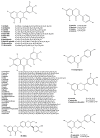Structure-activity association of flavonoids in lung diseases
- PMID: 24662074
- PMCID: PMC6271797
- DOI: 10.3390/molecules19033570
Structure-activity association of flavonoids in lung diseases
Abstract
Flavonoids are polyphenolic compounds classified into flavonols, flavones, flavanones, isoflavones, catechins, anthocyanidins, and chalcones according to their chemical structures. They are abundantly found in Nature and over 8,000 flavonoids have from different sources, mainly plant materials, have been described. Recently reports have shown the valuable effects of flavonoids as antiviral, anti-allergic, antiplatelet, antitumor, antioxidant, and anti-inflammatory agents and interest in these compounds has been increasing since they can be helpful to human health. Several mechanisms of action are involved in the biological properties of flavonoids such as free radical scavenging, transition metal ion chelation, activation of survival genes and signaling pathways, regulation of mitochondrial function and modulation of inflammatory responses. The anti-inflammatory effects of flavonoids have been described in a number of studies in the literature, but not frequently associated to respiratory disease. Thus, this review aims to discuss the effects of different flavonoids in the control of lung inflammation in some disorders such as asthma, lung emphysema and acute respiratory distress syndrome and the possible mechanisms of action, as well as establish some structure-activity relationships between this biological potential and chemical profile of these compounds.
Conflict of interest statement
The authors declare no conflict of interest.
Figures




References
-
- Caltagirone S., Ranelletti F.O., Rinelli A., Maggiano N., Colasante A., Musiani P., Aiello F.B., Piantelli M. Interaction with type II estrogen binding sites and antiproliferative activity of tamoxifen and quercetin in human non-small-cell lung cancer. Am. J. Respir. Cell Mol. Biol. 1997;17:51–59. doi: 10.1165/ajrcmb.17.1.2728. - DOI - PubMed
-
- Ranelletti F.O., Ricci R., Larocca L.M., Maggiano N., Capelli A., Scambia G., Benedetti-Panici P., Mancuso S., Rumi C., Piantelli M. Growth-inhibitory effect of quercetin and presence of type-II estrogen-binding sites in human colon-cancer cell lines and primary colorectal tumors. Int. J. Cancer. 1992;50:486–492. doi: 10.1002/ijc.2910500326. - DOI - PubMed
Publication types
MeSH terms
Substances
LinkOut - more resources
Full Text Sources
Other Literature Sources
Medical
Miscellaneous

